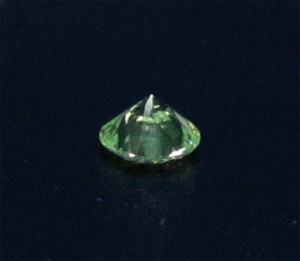
The next phase of differentiation occurs during the growth of crystal structures, making it one of the most significant features imparted onto a diamond. As mentioned previously, diamonds are formed in the earth’s crust over the course of hundreds of billions of years; the rate of growth is extremely small and the pressures exerted are immense. This is the key feature one proprietary detector uses to identify lab-grown diamonds. With natural diamonds, changing temperatures and pressures result in a growth pattern that is quite erratic and random, and is observed as a spider web pattern throughout the stone when viewed through this particular detector.
With HPHT lab-growns, the initial diamond seed is placed in the middle of the anvil where four pistons exert very high constant pressure under very high stable temperatures. The result is a crystal exhibiting a telltale cross pattern that can also be easily viewed with this proprietary technology. CVD diamonds, on the other hand, are a result of layers of carbon atoms precipitating on a carbon seed plate, allowing for the seed plate or individual growth layers to be observed in some cases.
Though these attributes can be sometimes observed under magnification—in particular, the layering characteristic of CVD diamonds—technology exists that is better suited to identify these features.

The last phase in differentiation occurs as a result of the environment in which the diamond crystal grows. In the case of naturally occurring diamonds, remnants of the environment are often found within the stone and, in some cases, they are included crystals of smaller diamonds or gemstones. With the use of high magnification, these foreign objects can be easily identified and would clearly prove the diamond’s natural origin. In the case of CVD stones, there are no foreign impurities that can contaminate the crystal due to the high concentration of carbon gas precipitated onto a diamond seed in the growing chamber. The only defect that does occur is graphite crystallization within the diamond crystal, since the temperature at which the CVD process occurs is ideal for graphite growth. As for HPHT diamonds, impurities are always metallic in nature and are the result of contamination from metal flux, which is the carrier of a colouring or colour-removing agent added to the initial ingredient. Once the HPHT process begins, the metal flux separates from the agent and reforms as metallic inclusions within the diamond crystal.
It would appear companies that make synthetic diamonds are coming on strong in pitching their product to the trade. In fact, at the time of this article’s writing, I had just received an e-mail from a manufacturer advertising small lab-grown diamonds for sale at JCK Las Vegas. Though it may appear the issue of synthetic diamonds is being addressed by major diamond manufacturers and dealers with varying results, I would suggest based on the findings of my colleague, Isaac Mimar, outlined here, that undisclosed lab-growns are indeed in secondary markets like Canada. The question remains, what will we do as an industry to ensure the natural diamond pipeline remains unpolluted of undisclosed synthetics?
 Hemdeep Patel is head of marketing and product development of Toronto-based HKD Diamond Laboratories Canada, an advanced gemstone and diamond laboratory with locations in Bangkok, Thailand, and Mumbai, India. He also leads Creative CADworks, a 3D CAD jewellery design and production firm. Holding a B.Sc. in physics and astronomy, Patel is a third-generation member of the jewellery industry, a graduate gemmologist, and vice-president of the Ontario chapter of the GIA alumni association. Patel can be contacted via e-mail at hemdeep@hkdlab.ca or sales@creativecadworks.ca.
Hemdeep Patel is head of marketing and product development of Toronto-based HKD Diamond Laboratories Canada, an advanced gemstone and diamond laboratory with locations in Bangkok, Thailand, and Mumbai, India. He also leads Creative CADworks, a 3D CAD jewellery design and production firm. Holding a B.Sc. in physics and astronomy, Patel is a third-generation member of the jewellery industry, a graduate gemmologist, and vice-president of the Ontario chapter of the GIA alumni association. Patel can be contacted via e-mail at hemdeep@hkdlab.ca or sales@creativecadworks.ca.





